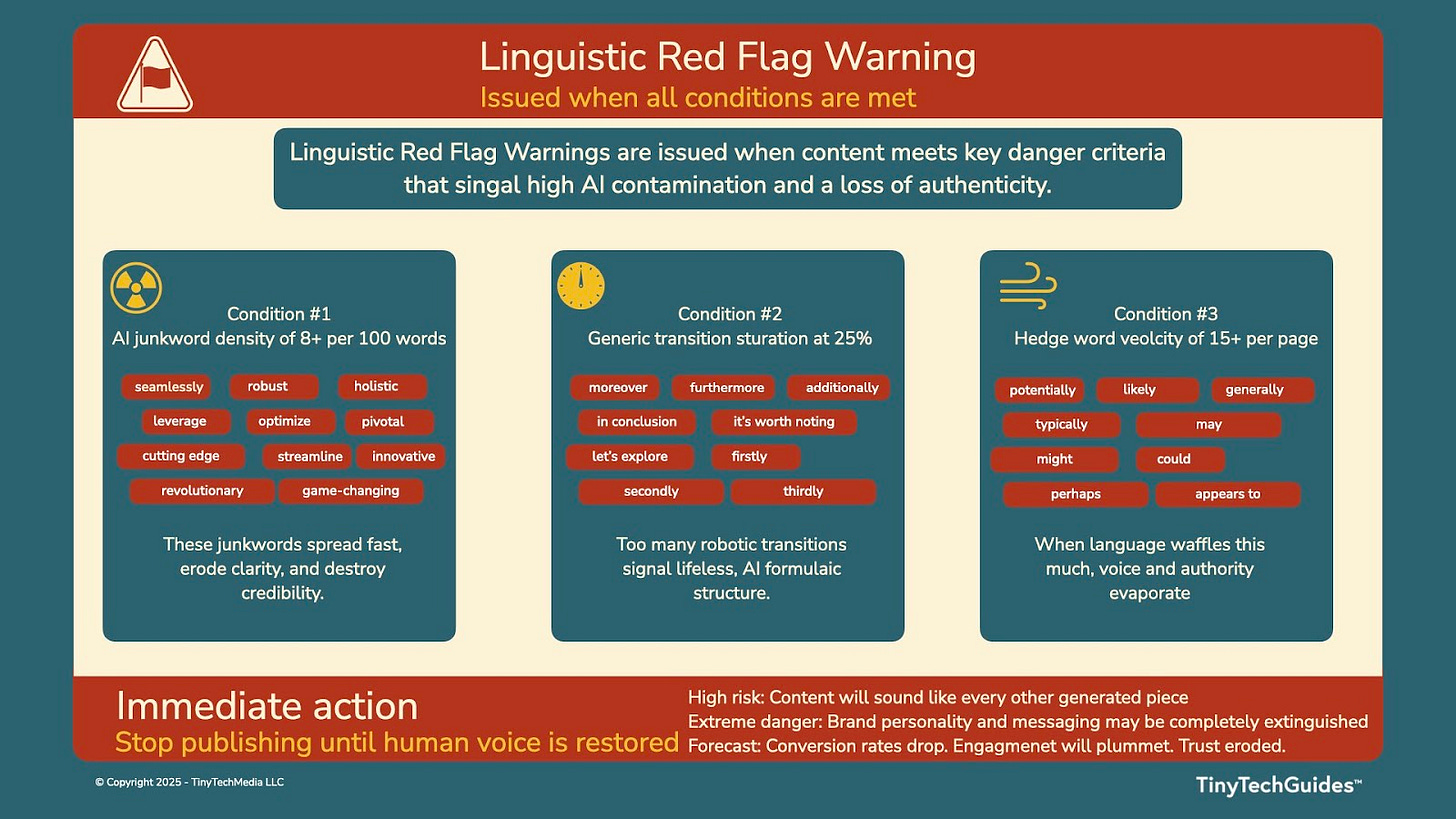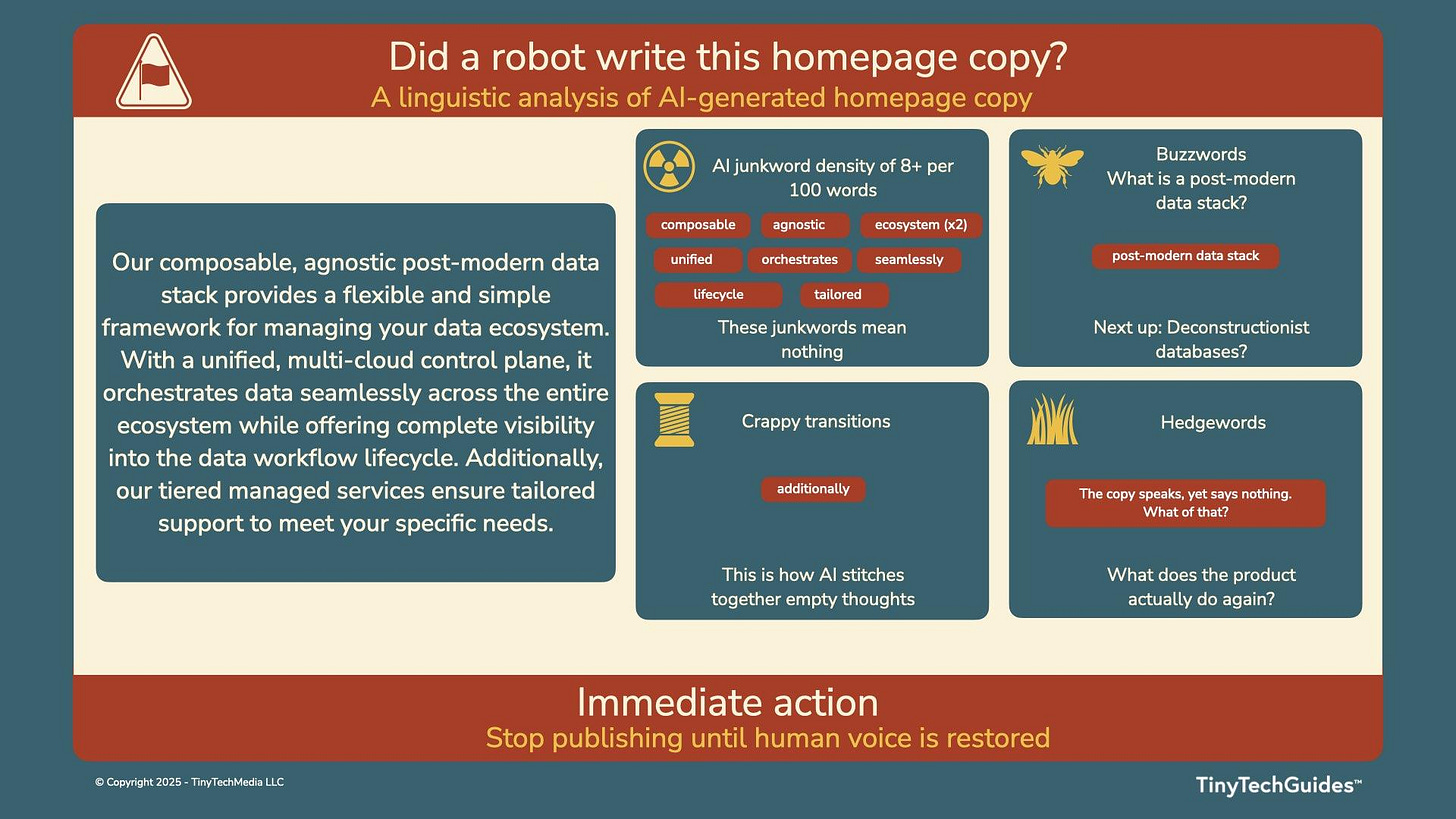How to Spot AI-Generated Content: Red Flags Every Marketer Must Know
The linguistic patterns that expose bot-generated copy
The second blog in a series discussing the great enshittification of the written word
Linguistic Red Flag Warnings - Take Immediate Action if Content is Written by AI
I was perusing the internet the other day and found something that stopped me in my tracks. This was on a real company's homepage (as of August 2025):
"Our composable, agnostic post-modern data stack provides a flexible and simple framework for managing your data ecosystem. With a unified, multi-cloud control plane, it orchestrates data seamlessly across the entire ecosystem while offering complete visibility into the data workflow lifecycle. Additionally, our tiered managed services ensure tailored support to meet your specific needs."
I've read this a dozen times and still don't understand what this company actually does. Do you?
What a human PMM would write instead: "Stop trying to piece together five different data tools that don't talk to each other. We built one platform that actually works with your stack."
We're drowning in AI-generated drivel that sounds professional but says nothing. What of that?
Did a robot write this home page copy?
The language death spiral
Here's something that's been bugging me for years. Or at least since gen AI emerged from the shadows a few years ago. When I learned English in school, we placed adverbs before verbs: "He quietly took up his harpoon" (Melville), not "He took up his harpoon quietly."
AI dumps them at the ends of sentences because it's easier than figuring out proper placement. Research shows that AI-generated text produces what linguists call ‘right-branching adverbial clauses,’ where adverbs consistently appear at sentence endings rather than their natural positions.[1] This creates the instruction manual tone that makes content feel robotic rather than human.
"Our platform integrates seamlessly"
"The solution scales effortlessly"
"Teams collaborate effectively"
Then AI adds academic transitions like "Moreover" and "Furthermore" because it learned from millions of business documents where every paragraph needs a formal introduction (and conclusion). Finally, it hedges everything to death: "potentially," "likely," "generally."
Chuck Palahniuk didn't say "Tyler Durden likely started Fight Club." He said, "Tyler Durden started Fight Club." Take a damn stand!
Vocabulary decay at critical levels
Last November, I wrote about AI junkwords in what became one of my top-performing Medium articles. The response was overwhelming because people recognized the mind-numbing patterns permeating content:
seamlessly • robust • holistic • leverage • optimize • streamline • cutting-edge • game-changing • revolutionary • transform
Every SaaS company, consulting firm, and tech startup uses the same tired and worn vocabulary. When everyone's solution is "revolutionary", "cutting-edge," and “integrated,” nothing is. Most product marketers have defaulted to letting ChatGPT write their content, creating "a sea of bland posts about 'leveraging AI capabilities,' 'driving digital transformation,' and 'delving into topics.'"
Then there are the nonsensical AI phrases. "It's worth noting," "Let's dive deep," "At the end of the day," "In today's fast-paced world." These phrases are so overused that they've become the equivalent of "Have a nice day" — technically polite but completely meaningless.
Dickens painted industrial London's bleakness in Great Expectations without needing to "leverage cutting-edge innovation." Mary Shelley described scientific horror in Frankenstein without "optimizing workflows."
They used words that meant something. They used words with purpose.
Content that never dies
Why does this 37-page product guide or blog exist when a 3-page overview would work better?
Because AI mistakes word count for value. It generates 3,000 words to answer 300-word questions. It repeats the same point seven different ways, adds unnecessary context, and creates conclusions that summarize summaries. That’s a summary squared! I've seen this firsthand when working with clients whose LLMs couldn't even process their messaging frameworks stored in tables, forcing them to create unnecessarily long explanations of concepts that should be concise.
Mark Twain wrapped up Huckleberry Finn when Huck decided to "light out for the Territory." He understood natural stopping points. As he said, "If I had more time, I would have written a shorter letter."
Modern business writing seems to have forgotten this lesson.
The personality void
You can open any page of a Hemingway novel and know it’s Hemingway within a sentence. Same with Austen's wit or Dickens' social commentary. These writers had personalities that jumped off the page and painted a picture in your mind.
AI content sounds like it was written by a committee who’s terrified of offending anyone.
"We are pleased to announce enhanced capabilities that organizations can benefit from."
No passion. No frustration. No genuine excitement. It's the literary equivalent of beige wallpaper.
Real humans write like this: "Holy shit, this feature is going to save you hours of work." I mean, when I speak with product managers, that’s how they speak about even the most mundane of features. Why have we lost this visceralness? As messaging expert Emma Stratton puts it, "You can have the best products in the world. That is actually the answer to this person's dreams, but if you just spit a bunch of jargon and technical gobbledygook at them, they're not going to see it, and they're going to go.”[2]
The simple test
Read what you write. Read it out loud. Use your ears and brain.
Does it sound like something you'd actually say? Or does it sound like a press release written by someone who has no idea what they’re talking about?
Why this matters more than you think
I've been in B2B marketing for over a decade, written ten books before AI made writing cool, and helped launch dozens of products. I've seen companies with superior technology lose to competitors with better messaging. This is a recurring pattern that I’ve documented across multiple client engagements and podcast interviews. As product marketing consultant Gabriela Contreras said during our recent conversation, the key is making "your customer the hero in their organization... helping them get their next promotion... helping them look good in front of their boss."[3]
Remember, no one actually cares about your product or how shiny the buttons are. They care about genuineness, authenticity, and trust. And mostly, they want to be confident that your wares will solve their woes.
Your content isn't just marketing material. It's how prospects decide whether they trust you with their budget. It's how employees understand your company's personality. It's how investors evaluate your leadership.
When your content sounds like everyone else's and enters the “sea of sameness,” you’re forgotten. When it sounds like a robot wrote it, you become untrustworthy.
The companies that maintain that authentic human voice will own the attention economy and occupy mindshare.
Your move
Stop outsourcing your brain to AI. Use it to brainstorm and create outlines, but not for your voice. As Emma Stratton put it, "Making something simple isn't about dumbing it down… making it simple is about making it quickly and easily understood by your reader. That's what simplicity is about. So it's almost like accessibility for your reader."[4] This applies whether you're writing with AI assistance or completely from scratch.
Count your junkwords. Circle your hedge words. Check for adverbs trailing at sentence ends like sad punctuation. If your content could be cut in half without losing meaning, you've been infected.
So what can you do? It’s simple. Put down the ChatGPT and Gemini prompt and pick up a pen. Or fingers to keys, if you're like me.
Write like you speak; no one likes corporate mode.
Your readers will thank you. Your conversion rates will thank you. And you might even remember why you started writing in the first place.
Next up: The punctuation patterns that scream "I was generated by a bot"—because apparently AI thinks personality comes from em dashes and emojis.
If this resonated, share it with a fellow PMM who's tired of swimming in AI slop. For more insights on creating distinctive B2B messaging, check out my complete analysis of why your messaging might be falling flat and practical frameworks for standing out in saturated markets.
Related reading: Your LLM's So Smart, It's Missing the Pepperoni | Stop Blending In: Creating Content That Actually Matters | The PMM's Prompt Playbook
[1] David Sweenor, "Spotting AI Junk Words: Why AI Still Can't Write Like Humans," Medium, November 18, 2024, https://medium.com/@davidsweenor/spotting-ai-junk-words-why-ai-still-cant-write-like-humans-228de682d876.
[2] Emma Stratton, "How to Write Punchy B2B Messaging That Actually Converts," Data Faces Podcast, August 12, 2025, https://prompts.tinytechguides.com/p/how-to-write-punchy-b2b-messaging.
[3] Gabriela Contreras, "The Customer Hero Principle: Why Your B2B Messaging Falls Flat," Data Faces Podcast, May 6, 2025, https://prompts.tinytechguides.com/p/the-customer-hero-principle-why-your.
[4] Emma Stratton, "How to Write Punchy B2B Messaging That Actually Converts," Data Faces Podcast, August 12, 2025, https://prompts.tinytechguides.com/p/how-to-write-punchy-b2b-messaging.



